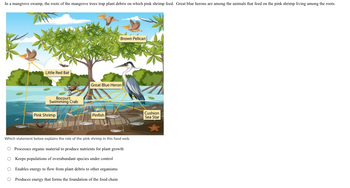
Human Anatomy & Physiology (11th Edition)
11th Edition
ISBN: 9780134580999
Author: Elaine N. Marieb, Katja N. Hoehn
Publisher: PEARSON
expand_more
expand_more
format_list_bulleted
Concept explainers
Question

Transcribed Image Text:In a mangrove swamp, the roots of the mangrove trees trap plant debris on which pink shrimp feed. Great blue herons are among the animals that feed on the pink shrimp living among the roots.
Little Red Bat
Bocourt
Swimming Crab
Pink Shrimp
Brown Pelican
Great Blue Heron
Pinfish
Which statement below explains the role of the pink shrimp in this food web.
O Processes organic material to produce nutrients for plant growth
O Keeps populations of overabundant species under control
O Enables energy to flow from plant debris to other organisms
O Produces energy that forms the foundation of the food chain
Cushion
Sea Star
Expert Solution
This question has been solved!
Explore an expertly crafted, step-by-step solution for a thorough understanding of key concepts.
This is a popular solution
Trending nowThis is a popular solution!
Step by stepSolved in 3 steps

Knowledge Booster
Learn more about
Need a deep-dive on the concept behind this application? Look no further. Learn more about this topic, biology and related others by exploring similar questions and additional content below.Similar questions
- What is often true of a population of organisms with a type IIl suvivorship curve? they produce few offspirng and invest more energy in each offspring O they produce more offspring and invest little energy in each Othey have low death rates during early life stages O they are equally likely to die at any agearrow_forwardAt which trophic level would you expect to find the highest concentration of a biomagnifying toxin? O primary producer herbivore mesopredator top carnivore primary consumerarrow_forwardMatch the levels to the last of the food chainarrow_forward
- DNA Fragment wich Human Gene Recombinant Plasmid Plasmid Vector Bacterial DNA Recombinant Plasmid Transformed Bacterial Cell Bacterial Cell Produces Human Protein Genes for medically important proteins can be cloned and inserted into bacteria resulting in recombinant bacterial DNA, as shown in the diagram below. Why can bacteria recognize a human gene and then produce a human protein? Bacterial cells and human cells contain the same kind of chromosomes Bacterial cells contain the same organelles as human cells O DNA replication in bacteria and humans is the same O The basic components of DNA are the same in humans and bacteriaarrow_forwardFill in the blank with the correct word: According to theory, excluding the herbivore deer should lead to small mammal abundance in the exclosure. greater O lowerarrow_forward1. Examine the food webs for Lake Victoria, East Africa (fig 31.2 a,b) before and after the introduction of the Nile perch (Leveque 1995). Calculate the mean food chain length, percent of trophic groups at various levels, and connectance for each food web. Oreochromis Insectivorous Fish Chironomids Chaoborous Man Piscivorous Fish Zooplanktivorous Haplochromines Rastrineobola Zooplankton Detritus/Phytoplankton Lake Victoria in the 1970s Detritivorous Phytoplanktivorous Haplochromines Figure 31.2. (a) Food web structure of Lake Victoria before introduction of the Nile Perch. [continued on next page) Molluscivorous Fish Molluscsarrow_forward
- What is the difference between primary consumers and tertiary consumers? A. Primary consumers are carnivorous; tertiary consumers are omnivorous or carnivorous. B. Primary consumers are herbivorous; tertiary consumers are omnivorous or carnivorous. C. Primary consumers are carnivorous; tertiary consumers are herbivorous. D. Primary consumers metabolism chemical energy; tertiary consumers require plants or animalsarrow_forwardWhich living thing will ultimately get the least amount of energy in a food chain? deer wolf grass vulturearrow_forwardDescribe some ways in which humans have increased our carrying capacity over time. Do you think that humans have currently reached our carrying capacity? Explain.arrow_forward
arrow_back_ios
arrow_forward_ios
Recommended textbooks for you
 Human Anatomy & Physiology (11th Edition)BiologyISBN:9780134580999Author:Elaine N. Marieb, Katja N. HoehnPublisher:PEARSON
Human Anatomy & Physiology (11th Edition)BiologyISBN:9780134580999Author:Elaine N. Marieb, Katja N. HoehnPublisher:PEARSON Biology 2eBiologyISBN:9781947172517Author:Matthew Douglas, Jung Choi, Mary Ann ClarkPublisher:OpenStax
Biology 2eBiologyISBN:9781947172517Author:Matthew Douglas, Jung Choi, Mary Ann ClarkPublisher:OpenStax Anatomy & PhysiologyBiologyISBN:9781259398629Author:McKinley, Michael P., O'loughlin, Valerie Dean, Bidle, Theresa StouterPublisher:Mcgraw Hill Education,
Anatomy & PhysiologyBiologyISBN:9781259398629Author:McKinley, Michael P., O'loughlin, Valerie Dean, Bidle, Theresa StouterPublisher:Mcgraw Hill Education, Molecular Biology of the Cell (Sixth Edition)BiologyISBN:9780815344322Author:Bruce Alberts, Alexander D. Johnson, Julian Lewis, David Morgan, Martin Raff, Keith Roberts, Peter WalterPublisher:W. W. Norton & Company
Molecular Biology of the Cell (Sixth Edition)BiologyISBN:9780815344322Author:Bruce Alberts, Alexander D. Johnson, Julian Lewis, David Morgan, Martin Raff, Keith Roberts, Peter WalterPublisher:W. W. Norton & Company Laboratory Manual For Human Anatomy & PhysiologyBiologyISBN:9781260159363Author:Martin, Terry R., Prentice-craver, CynthiaPublisher:McGraw-Hill Publishing Co.
Laboratory Manual For Human Anatomy & PhysiologyBiologyISBN:9781260159363Author:Martin, Terry R., Prentice-craver, CynthiaPublisher:McGraw-Hill Publishing Co. Inquiry Into Life (16th Edition)BiologyISBN:9781260231700Author:Sylvia S. Mader, Michael WindelspechtPublisher:McGraw Hill Education
Inquiry Into Life (16th Edition)BiologyISBN:9781260231700Author:Sylvia S. Mader, Michael WindelspechtPublisher:McGraw Hill Education

Human Anatomy & Physiology (11th Edition)
Biology
ISBN:9780134580999
Author:Elaine N. Marieb, Katja N. Hoehn
Publisher:PEARSON

Biology 2e
Biology
ISBN:9781947172517
Author:Matthew Douglas, Jung Choi, Mary Ann Clark
Publisher:OpenStax

Anatomy & Physiology
Biology
ISBN:9781259398629
Author:McKinley, Michael P., O'loughlin, Valerie Dean, Bidle, Theresa Stouter
Publisher:Mcgraw Hill Education,

Molecular Biology of the Cell (Sixth Edition)
Biology
ISBN:9780815344322
Author:Bruce Alberts, Alexander D. Johnson, Julian Lewis, David Morgan, Martin Raff, Keith Roberts, Peter Walter
Publisher:W. W. Norton & Company

Laboratory Manual For Human Anatomy & Physiology
Biology
ISBN:9781260159363
Author:Martin, Terry R., Prentice-craver, Cynthia
Publisher:McGraw-Hill Publishing Co.

Inquiry Into Life (16th Edition)
Biology
ISBN:9781260231700
Author:Sylvia S. Mader, Michael Windelspecht
Publisher:McGraw Hill Education